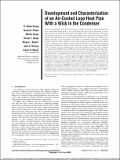| dc.contributor.author | Kariya, Harumichi Arthur | |
| dc.contributor.author | Peters, Teresa B. | |
| dc.contributor.author | Cleary, Martin | |
| dc.contributor.author | Hanks, Daniel Frank | |
| dc.contributor.author | Staats, Wayne Lawrence | |
| dc.contributor.author | Brisson II, John G | |
| dc.contributor.author | Wang, Evelyn | |
| dc.date.accessioned | 2017-05-03T21:06:12Z | |
| dc.date.available | 2017-05-03T21:06:12Z | |
| dc.date.issued | 2013-10 | |
| dc.date.submitted | 2013-04 | |
| dc.identifier.issn | 1948-5085 | |
| dc.identifier.uri | http://hdl.handle.net/1721.1/108657 | |
| dc.description.abstract | Thermal management of modern electronics is rapidly becoming a critical bottleneck of their computational performance. Air-cooled heat sinks offer ease and flexibility in installation and are currently the most widely used solution for cooling electronics. We report the characterization of a novel loop heat pipe (LHP) with a wick in the condenser, developed for the integration into an air-cooled heat sink. The evaporator and condenser are planar (102 mm × 102 mm footprint) and allow for potential integration of multiple, stacked condensers. The condenser wick is used to separate the liquid and vapor phases during condensation by capillary menisci and enables the use of multiple condensers with equal condensation behavior and performance. In this paper, the thermal–fluidic cycle is outlined, and the requirements to generate capillary pressure in the condenser are discussed. The LHP design to fulfill the requirements is then described, and the experimental characterization of a single-condenser version of the LHP is reported. The thermal performance was dependent on the fan speed and the volume of the working fluid; a thermal resistance of 0.177 °C/W was demonstrated at a heat load of 200 W, fan speed of 5000 rpm and fluid volume of 67 mL. When the LHP was filled with the working fluid to the proper volume, capillary pressure in the condenser was confirmed for all heat loads tested, with a maximum of 3.5 kPa at 200 W. When overfilled with the working fluid, the condenser was flooded with liquid, preventing the formation of capillary pressure and significantly increasing the LHP thermal resistance. This study provides the detailed thermal–fluidic considerations needed to generate capillary pressure in the condenser for controlling the condensation behavior and serves as the basis of developing multiple-condenser LHPs with low thermal resistance. | en_US |
| dc.description.sponsorship | United States. Defense Advanced Research Projects Agency (W31P4Q-09-1-0007) | en_US |
| dc.language.iso | en_US | |
| dc.publisher | ASME International | en_US |
| dc.relation.isversionof | http://dx.doi.org/10.1115/1.4025049 | en_US |
| dc.rights | Article is made available in accordance with the publisher's policy and may be subject to US copyright law. Please refer to the publisher's site for terms of use. | en_US |
| dc.source | American Society of Mechanical Engineers (ASME) | en_US |
| dc.title | Development and Characterization of an Air-Cooled Loop Heat Pipe With a Wick in the Condenser | en_US |
| dc.type | Article | en_US |
| dc.identifier.citation | Kariya, H. Arthur; Peters, Teresa B.; Cleary, Martin; Hanks, Daniel F.; Staats, Wayne L.; Brisson, John G. and Wang, Evelyn N.. “Development and Characterization of an Air-Cooled Loop Heat Pipe With a Wick in the Condenser.” Journal of Thermal Science and Engineering Applications 6, no. 1 (October 2013): 011010. © 2013 American Society of Mechanical Engineers | en_US |
| dc.contributor.department | Massachusetts Institute of Technology. Department of Mechanical Engineering | en_US |
| dc.contributor.mitauthor | Kariya, Harumichi Arthur | |
| dc.contributor.mitauthor | Peters, Teresa B. | |
| dc.contributor.mitauthor | Cleary, Martin | |
| dc.contributor.mitauthor | Hanks, Daniel Frank | |
| dc.contributor.mitauthor | Staats, Wayne Lawrence | |
| dc.contributor.mitauthor | Brisson II, John G | |
| dc.contributor.mitauthor | Wang, Evelyn | |
| dc.relation.journal | Journal of Thermal Science and Engineering Applications | en_US |
| dc.eprint.version | Final published version | en_US |
| dc.type.uri | http://purl.org/eprint/type/JournalArticle | en_US |
| eprint.status | http://purl.org/eprint/status/PeerReviewed | en_US |
| dspace.orderedauthors | Kariya, H. Arthur; Peters, Teresa B.; Cleary, Martin; Hanks, Daniel F.; Staats, Wayne L.; Brisson, John G.; Wang, Evelyn N. | en_US |
| dspace.embargo.terms | N | en_US |
| dc.identifier.orcid | https://orcid.org/0000-0002-8974-756X | |
| dc.identifier.orcid | https://orcid.org/0000-0003-2473-9494 | |
| dc.identifier.orcid | https://orcid.org/0000-0001-7045-1200 | |
| mit.license | PUBLISHER_POLICY | en_US |
